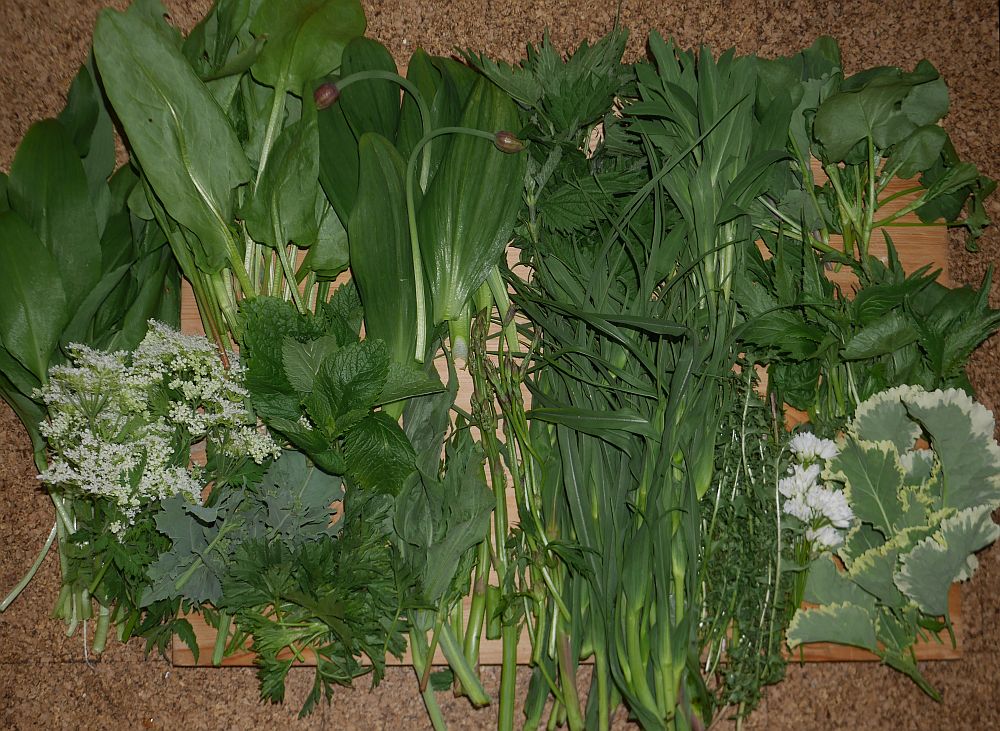It’s currently in full flower, so here’s a few pictures of my biggest expanding patch!
Rice lily
It’s currently in full flower, so here’s a few pictures of my biggest expanding patch!
AROUND THE WORLD IN THE EDIBLE GARDEN; Part 3 – Southern Europe and the Mediterranean countries
Inviting you to the third in a series of dinners from Malvik’s Edible Garden where we “forage” from different parts of the world!
If you’ve visited countries in south east Europe you will no doubt have eaten the delicious vegetable pies like Greek spanakopoita, Turkish börek, Italian Torta pasqualina, Bulgarian banitsa and others. Inspired by these and not wanting to make the time consuming to make filo pastry, we made a 100% wholegrain rye/barley quiche like dish with large quantities of the following perennial greens:
From left to right (from top left) :
Allium ursinum (ramsons; ramsløk)
Rumex patientia (patience dock; hagesyre)
Urtica dioica (stinging nettle; brennesle)
Silene vulgaris (bladder campion; engsmelle)
Rumex scutatus (Buckler-leaved sorrel; Fransksyre)
Rumex acetosa (sorrel; engsyre)
Myrrhis odorata (sweet cicely; Spansk kjørvel)
Malva alcea (hollyhock mallow; rosekattost)
Melissa officinalis (lemon balm; sitronmelisse)
Scorzonera hispanica (Scorzonera; scorsonnerot, svartrot)
Asparagus officinalis (asparagus; asparges)
Humulus lupulus (hops; humle)
Tragopogon pratensis (Jack-go-to-bed-at-noon; geitskjegg)
Taraxacum “Moss-leaved dandelion”
Campanula trachelium (nettle-leaved bellflower; nesleklokke)
Brassica oleracea “Daubenton variegated” (perennial kale; flerårige kål)
Allium zebdanense (white flowers) from Lebanon
(with garlic and chili and imported olives)
I’ve been unable to find any ethnobotanical documentation that native americans used Trilliums (wakerobins) for food. They were rather considered as medicinal plants (see http://naeb.brit.org/uses/search/?string=trillium) and was also thought of as a poisonous plant by some tribes. The roots do however contain saponins. Nevertheless, it is used and considered to be edible (cooked as greens and used in mixed salads by modern day foragers) and this is also mentioned in some foraging books. It is a protected plant in some areas and I do not recommended to harvest it from the wild as it is vulnerable to overharvest as it takes many years to reach the flowering stage..
I started collecting Trilliums as potentially interesting edimentals, and have eaten a few leaves (as reported the taste is a bit like sunflower seeds) and I use flowers to decorate salads. I would never be able to eat a lot of it anyway and wouldn’t do so either to be on the safe side and don’t recommend others do so either.
We’re now at the height of Trillium flowering season here, so here’s a few pictures taken on 1st June. Please let me know if you see any wrongly identified plants (there may well be hybrids in here!)